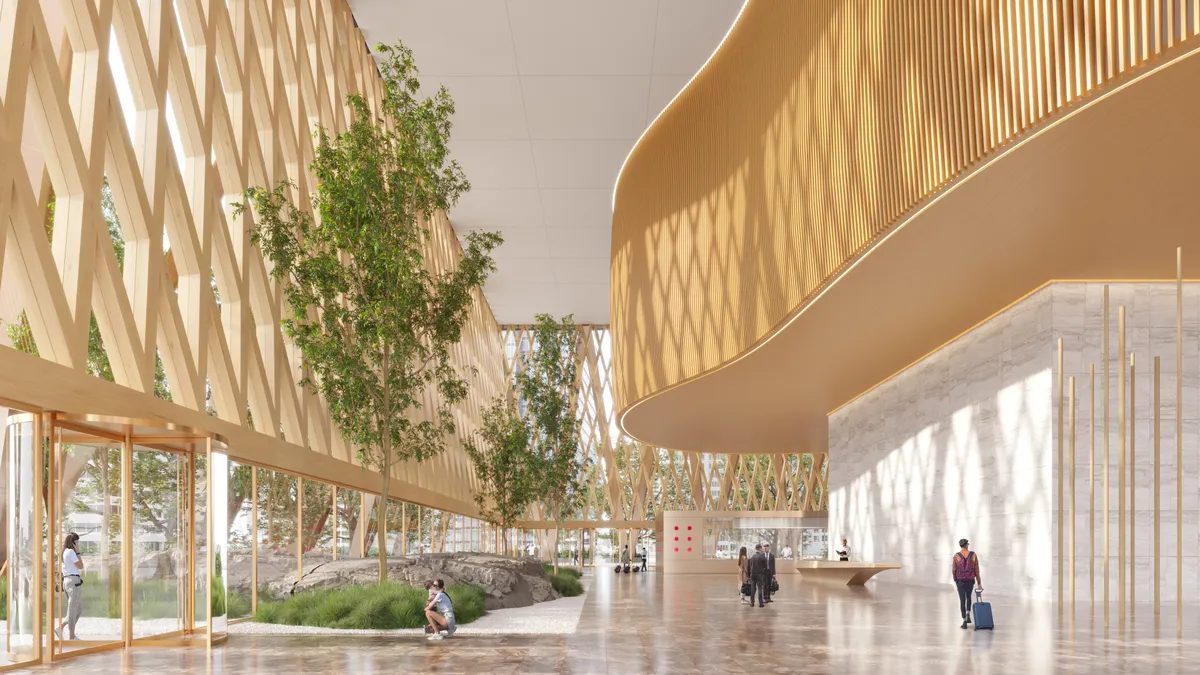Milwaukee, Wisconsin, is set to erect a 25-story mass timber apartment building in the summer of 2022, marking the world's tallest building of its kind — that is, until it's eclipsed by a 40-story mass timber office building expected to tower over Sydney, Australia by 2025.
The race to build the world's tallest mass timber building illustrates the enthusiasm among many architects and developers to use eco-friendly building material in driving a sustainable recovery from the COVID-19 pandemic, experts say.
Mass timber construction utilizes various types of engineered wood, with cross-laminated timber (CLT) being the most common panel material. Mass timber structures are touted for their long lifespans, and their unique ability to remove carbon from the atmosphere can support cities hoping to reduce greenhouse gas (GHG) emissions from their buildings sectors. In fact, a piece of land with no building on it has a higher carbon footprint than land with a CLT building, according to The Climate Trust.
The material is cost-effective and requires little energy to manufacture, according to Maura Krause, a partner at the law firm Goldberg Segalla. Building with mass timber involves off-site fabrication and on-site construction or assembly of the product. It's also a more lightweight material than concrete or steel, and can be used with smaller crews and simpler products, Krause said.
Climbing higher
Canadian-based DIALOG is one design firm aiming to help local leaders tap into those climate benefits with their recent patent-pending prototype of a mass timber tower that could climb 105 stories high. The prototype would be a "key node of dense transit-oriented development in a largely suburban environment," the company website reads.
"One of the things that made this project so sustainable is, it wasn't just about a tall mass timber project, it was also about making it zero-carbon," said Craig Applegath, a founding principal of DIALOG. To achieve a zero-carbon design, the firm incorporated two key solutions: photovoltaics and an algae bioreactor.
The building's east, west and south facades are integrated with photovoltaics, which help it generate up to 25% of its electrical power from the sun depending on the season, according to Applegath.
The design also taps an algae bioreactor from Pond Technologies. "What we have in the basement is a co-generation [plant] that runs on natural gas," Applegath said. "And after it is burned for the turbine, the emissions … from that generator go into a large tank... and in that tank is a high intensity and high efficiency LED light of a frequency that stimulates the growth of algae."
The algae then "chews up" the carbon dioxide, essentially removing carbon dioxide from the loop. "I think it's one of the silver bullets for climate change," Applegath said.
While not all mass timber projects include these designs, the DIALOG building is an example of such projects laying the groundwork to potentially support more ambitious sustainability efforts.
Hurdles and opportunities
Mass timber does present some challenges for developers. Timber supply, building codes and investments have been obstacles for the wood industry, while local leaders might may face backlash from the concrete and steel industry for the use of the material.
"There are sectors that don't want wood to succeed, because it would take a bite out of their market," said Mark Rudnicki, professor at Michigan Tech University's School of Forest Resources and Environmental Science, in an earlier interview.
Regardless, there will certainly be more opportunities for investments in green infrastructure as Canada recovers from COVID-19, Applegath said. There will also be opportunities for more U.S. investments in President-Elect Joe Biden's administration, he said.
Biden has a $2 trillion climate plan, focused on renewable energy and electrification, that calls for the retrofit of 4 million buildings, an end to carbon-based electrical generation by 2035, and significant investments that would create millions of jobs to support the construction of energy-efficient public housing.
"Biden has a pretty aggressive plan for a modern and sustainable infrastructure that he plans to put in place immediately upon coming into office. And if it is put in place, it's going to have a very real impact on green construction and green materials," Krause said.
Biden's proposed climate efforts also come as more investors have their eye on sustainability, with the American Council on Renewable Energy recently ranking energy storage as the "most desirable" sector to invest.
"While many seem to be skeptical of how the changes that come with the green plan could be possible in a four-year term, just take a look at how fast we adapted to change in a five-month period due to COVID-19," Krause said in a statement. "Anything is possible at this point."





















